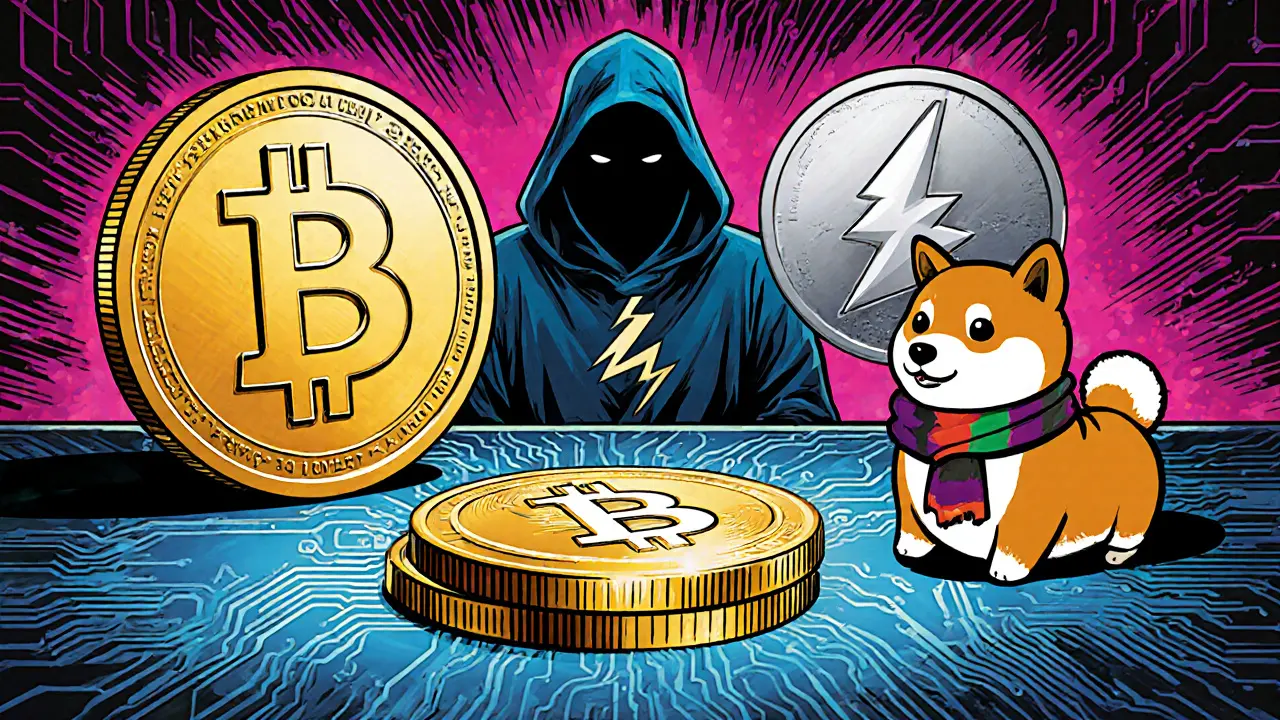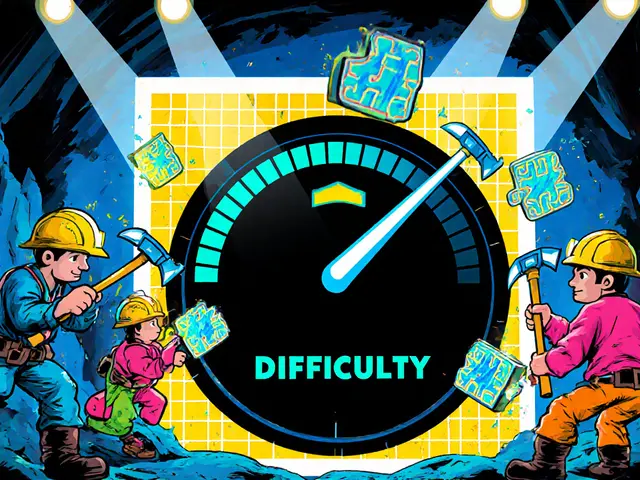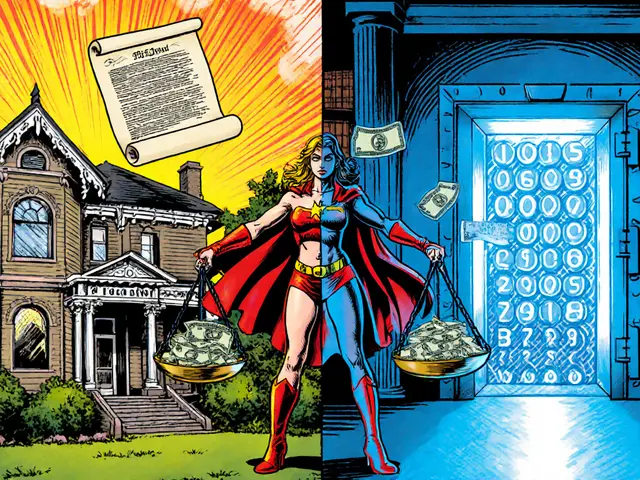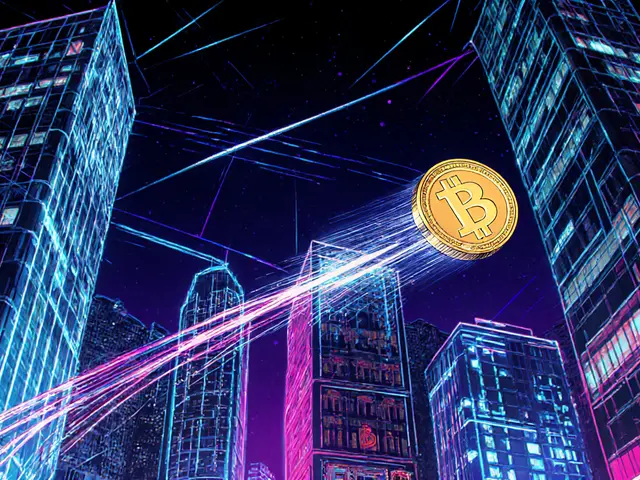Payment Cryptocurrency Comparison Tool
Bitcoin (BTC)
21M supply 10 min blockLitecoin (LTC)
84M supply 2.5 min blockMonero (XMR)
Unlimited High privacyDogecoin (DOGE)
Unlimited 1 min blockBitcoin Cash (BCH)
21M supply 10 min blockSelected Coin Details
Select a cryptocurrency to view its details
Quick Comparison Table
| Coin | Supply Cap | Avg. Block Time | Privacy Level | Typical Fee (USD) |
|---|
When people hear the word "crypto" they often picture wild price charts, but the core idea behind many digital currencies is simple: they let you move value without a bank. Payment cryptocurrencies are the subset of digital assets designed primarily for buying, selling, or sending money over the internet. Unlike utility tokens that power apps or governance tokens that vote on proposals, these coins focus on being a fast, cheap, and secure medium of exchange.
What Makes a Cryptocurrency a "Payment" Coin?
Four technical traits tend to separate payment cryptocurrencies from other digital tokens:
- Value‑transfer focus: Their core protocol is built around moving balances from one address to another.
- Capped or limited supply: Many have a hard maximum number of coins, which can help preserve value.
- Public, permission‑less ledger: Anyone can verify the transaction history on the blockchain.
- Mining or staking incentives: New coins are created by solving cryptographic puzzles (mining) or by locking up existing coins (staking).
Because these features remove the need for a centralized intermediary, payment cryptocurrencies promise lower fees, faster settlement, and global reach.
Key Examples and Their Unique Spins
Below are the most widely‑used payment cryptocurrencies, each with a distinct design goal.
- Bitcoin (BTC) - Launched in 2009, Bitcoin introduced the concept of a decentralized digital cash system. It caps supply at 21million coins, making it deflationary.
- Litecoin (LTC) - Created by Charlie Lee in 2011, Litecoin aims to be a cheaper, faster version of Bitcoin, with a 2.5‑minute block time and a supply limit of 84million.
- Monero (XMR) - Focuses on privacy; it hides sender, receiver, and amount using ring signatures and confidential transactions.
- Dogecoin (DOGE) - Started as a meme in 2013, it has an uncapped supply and low fees, making it popular for small‑value tips.
- Bitcoin Cash (BCH) - Forked from Bitcoin in 2017 to increase block size and lower transaction costs.
How Payments Actually Flow on a Blockchain
Every payment cryptocurrency runs on a public ledger called a blockchain. When you send coins, the following steps happen:
- Create a transaction: Your wallet software builds a message that says, “Move 0.01BTC from my address to yours,” and signs it with your private key.
- Broadcast to the network: The signed transaction is sent to peers (other nodes) who verify the signature and that you have enough balance.
- Mining or validation: Miners (or validators in proof‑of‑stake systems) bundle your transaction into a new block, solve a cryptographic puzzle, and add the block to the chain.
- Confirmation: Once the block is accepted by the majority, the network records the transfer permanently. More subsequent blocks mean higher security.
Because the ledger is distributed, no single party can rewrite history without controlling >50% of the network’s hash power-a scenario that is extremely expensive for large, established chains like Bitcoin.

Comparing Payment Cryptocurrencies
| Coin | Supply cap | Avg. block time | Privacy level | Typical fee (USD) |
|---|---|---|---|---|
| Bitcoin (BTC) | 21million | 10min | Low (transparent) | ≈$2.30 |
| Litecoin (LTC) | 84million | 2.5min | Low | ≈$0.01 |
| Monero (XMR) | Unlimited (dynamic) | 2min | High (ring signatures, stealth addresses) | ≈$0.05 |
| Dogecoin (DOGE) | Unlimited | 1min | Low | ≈$0.001 |
| Bitcoin Cash (BCH) | 21million | 10min | Low | ≈$0.03 |
The table shows why many users pick Litecoin for everyday purchases: it’s faster and cheaper than Bitcoin while still offering a capped supply.
Advantages Over Traditional Money
Payment cryptocurrencies bring three practical benefits that banks can’t match easily:
- Borderless transfers: Send funds to any country with an internet connection, often in minutes.
- Lower storage cost: No physical vaults; a wallet file or hardware device holds the assets.
- Deflationary pressure: Fixed supply can act as a hedge against inflation, especially for Bitcoin.
However, experts from the Reserve Bank of Australia point out a major drawback: price volatility. If a coin’s value swings 10% in a day, merchants can’t rely on it as a stable unit of account.
Limitations and Real‑World Adoption Hurdles
Despite the hype, payment cryptocurrencies still face stiff barriers:
- Volatility: Sudden price changes make it risky to price goods in crypto.
- Merchant acceptance: Only a small fraction of online stores take Bitcoin or other coins directly.
- Technical complexity: New users must manage wallets, backup seed phrases, and understand transaction fees.
- Regulatory scrutiny: Privacy‑focused coins like Monero are delisted from many exchanges, limiting access.
Surveys cited by Kaspersky reveal that most crypto holders never use their coins for everyday purchases; they mainly trade for profit.
Getting Started: A Simple Checklist
If you want to try a payment cryptocurrency for a purchase, follow these steps:
- Choose a wallet: For beginners, a mobile app such as Trust Wallet or a hardware device like Ledger offers a balance of security and ease of use.
- Buy the coin: Use a reputable exchange (Coinbase, Gemini, Kraken) to purchase Bitcoin, Litecoin, or another coin.
- Secure your seed phrase: Write it down on paper, store it offline, and never share it.
- Check fees and confirmations: Look at current network congestion; Litecoin usually confirms within 2‑3 minutes, while Bitcoin may take 10‑20 minutes.
- Make a test transaction: Send a tiny amount to a friend or a service that accepts crypto to confirm you understand the flow.
Once you’re comfortable, you can explore merchant integrations like BitPay or Coinbase Commerce, which convert incoming crypto into fiat instantly for the seller.
Future Outlook: Where Are Payment Cryptocurrencies Heading?
Recent network upgrades (Bitcoin’s Taproot activation, Litecoin’s MimbleWimble sidechain) aim to improve privacy and reduce transaction size. At the same time, central banks are piloting digital currencies that could compete with public payment crypto on speed but will remain fully regulated.
Industry analysts agree that widespread consumer use will likely depend on three factors:
- Stable‑coin bridges that lock crypto value to fiat for price certainty.
- Improved user experience-wallets that hide private‑key management from the average user.
- Clear regulatory frameworks that protect consumers without stifling innovation.
Even if crypto never replaces cash, it will remain a valuable tool for cross‑border remittances, niche ecommerce, and privacy‑sensitive transactions.
Frequently Asked Questions
Are payment cryptocurrencies the same as Bitcoin?
Bitcoin is the original payment cryptocurrency, but the term also covers coins like Litecoin, Monero, and Dogecoin that share the goal of moving money cheaply and quickly.
Can I use Bitcoin to buy groceries today?
Only a handful of supermarkets accept Bitcoin directly. Most shoppers use a payment‑processor service that instantly converts Bitcoin to local currency for the merchant.
Which payment crypto has the lowest fees?
Dogecoin and Litecoin generally have the cheapest fees, often under a cent. Fees rise during network congestion, so checking a fee estimator before sending is wise.
Is it safe to store payment crypto on an exchange?
Exchanges offer convenience but control the private keys, so they are attractive targets for hackers. For long‑term holdings, a hardware wallet is the most secure option.
What’s the biggest challenge for merchants accepting crypto?
Price volatility and the need for a reliable conversion method. Payment processors mitigate this by locking in the fiat value at the moment of sale.




Liam Wells
October 8, 2025 AT 21:43While the exposition enumerates the merits of payment cryptocurrencies, one must not overlook their inherent volatility; the alleged “lower fees” are, in practice, subject to sudden network congestion, causing fee spikes that rival traditional banking charges; moreover, the promised “borderless transfers” remain tethered to the whims of regulatory bodies, which can, at any moment, impose prohibitive compliance burdens; thus, the narrative presented is, at best, overly optimistic.
Darren Belisle
October 9, 2025 AT 08:50Great overview! It's refreshing to see how Litecoin offers faster confirmations, making everyday purchases feel more seamless; the comparison table really highlights the fee differences, and it's encouraging to know that options like Dogecoin keep transaction costs near zero, which can empower micro‑transactions worldwide.
Heather Zappella
October 9, 2025 AT 19:57The article does a solid job distinguishing payment cryptocurrencies from utility tokens; however, consider the cultural adoption patterns-Bitcoin enjoys broad recognition in Western markets, whereas Monero sees stronger usage among privacy‑conscious communities in Eastern Europe; furthermore, the fee structures can vary not only by coin but also by time of day, as network demand fluctuates dramatically.
Jason Wuchenich
October 10, 2025 AT 07:03If you're just starting out, the checklist at the end provides a clear roadmap; selecting a reputable wallet and testing a small transaction are excellent first steps, and remembering to verify fee estimates before sending helps avoid unexpected costs.
Jason Duke
October 10, 2025 AT 18:10Wow, the section on network upgrades like Taproot is exhilarating-these improvements are set to slash transaction sizes, boost privacy, and lower fees dramatically!! Imagine a future where sending a coffee costs just a fraction of a cent-such advancements are the very reason to stay excited about crypto.
Bryan Alexander
October 11, 2025 AT 05:17Absolutely! The excitement is palpable, and with each protocol tweak, the dream of frictionless global payments inches closer to reality-it's like watching a sci‑fi story unfold before our very eyes.
Nicholas Kulick
October 11, 2025 AT 16:23Payment cryptos function as decentralized ledgers; their value proposition rests on trustless transaction verification, which eliminates the need for centralized intermediaries.
Caleb Shepherd
October 12, 2025 AT 03:30Don't forget that many of these networks are subtly monitored by state actors; the so‑called “privacy” of Monero can be compromised if quantum computers become viable, allowing de‑anonymization of past transactions-stay vigilant.
Sal Sam
October 12, 2025 AT 14:37Indeed, the attack surface expands with each new cryptographic primitive; side‑channel exploits on ASIC firmware could leak key material, making even "privacy‑first" coins susceptible to correlation attacks.
Lara Decker
October 13, 2025 AT 01:43The comparison table overlooks the real cost of maintaining mining infrastructure, which can dwarf the nominal transaction fees for coins like Bitcoin, rendering the low-fee narrative misleading.
Anna Engel
October 13, 2025 AT 12:50Ah yes, because sorting out the energy consumption of mining rigs is exactly the deep philosophical question we all crave while choosing a payment method.
manika nathaemploy
October 13, 2025 AT 23:57i get why people love low fees, but also understand the fear of volatile prices-maybe using stablecoins as a bridge can help calm those nerves.
Mark Bosky
October 14, 2025 AT 11:03For newcomers, employing a hardware wallet such as Ledger or Trezor provides a robust security layer; ensure the device firmware is regularly updated to mitigate potential vulnerabilities.
Marcus Henderson
October 14, 2025 AT 22:10The evolution of payment cryptocurrencies mirrors humanity's pursuit of trustless exchange; as protocols mature, the balance between decentralization and usability will define their long‑term societal impact.
Debra Sears
October 15, 2025 AT 09:17I'm curious how merchant adoption rates differ regionally; do stores in Europe favor Bitcoin Cash over Litecoin due to lower fees, or is it more about brand recognition?
Matthew Laird
October 15, 2025 AT 20:23It's downright irresponsible to promote these volatile coins without warning that they can ruin personal finances; governments must step in before the next bubble bursts.
Caitlin Eliason
October 16, 2025 AT 07:30💥 Absolutely! The reckless hype around crypto is a ticking time bomb, and we need stricter regulations now before more innocent people get burned.
Ken Pritchard
October 16, 2025 AT 18:37When advising beginners, stress the importance of backing up seed phrases in multiple secure locations; redundancy prevents loss due to device failure.
Brian Lisk
October 17, 2025 AT 05:43Looking ahead, the trajectory of payment cryptocurrencies appears both promising and challenging; first, continuous protocol upgrades such as Taproot for Bitcoin and MimbleWimble sidechains for Litecoin are set to enhance privacy and reduce transaction sizes, thereby lowering fees; second, the integration of lightning networks provides near‑instant off‑chain settlements, making micro‑payments feasible for everyday use; third, the emergence of stablecoin bridges offers a hedge against the notorious volatility that deters many potential users; fourth, regulatory clarity in major economies could foster institutional confidence, encouraging wider merchant adoption; fifth, user experience improvements in wallet design are simplifying key management, allowing non‑technical users to manage assets securely; sixth, educational initiatives spearheaded by community groups are demystifying blockchain concepts, reducing the intimidation factor; seventh, cross‑chain interoperability protocols are enabling seamless value transfer between disparate networks, expanding the utility of each coin; eighth, the rise of decentralized finance (DeFi) platforms is creating novel payment use cases, such as automated salary disbursements in crypto; ninth, environmental concerns are being addressed through proof‑of‑stake transitions, reducing the carbon footprint of networks like Ethereum; tenth, the growing acceptance of crypto as a tax‑deductible expense in some jurisdictions may incentivize businesses to adopt payment solutions; eleventh, partnerships between crypto payment processors and point‑of‑sale systems are streamlining the checkout experience; twelfth, advancements in biometric authentication are enhancing wallet security without compromising convenience; thirteenth, the proliferation of layer‑2 scaling solutions promises to keep transaction costs low even under heavy network load; fourteenth, community governance models are becoming more inclusive, allowing stakeholders to influence roadmap decisions; and finally, the cultural shift toward digital‑first economies ensures that payment cryptocurrencies will remain relevant as global commerce continues to digitize.
Richard Bocchinfuso
October 17, 2025 AT 16:50i cant believe people still treat crypto like a get‑rich‑quick scheme, it's just a tool and should be used responsibly, not as a playground for reckless speculation.
Melanie LeBlanc
October 18, 2025 AT 03:57Think of your crypto journey as a garden; plant the seeds with careful research, water them with consistent security practices, and watch them flourish into a resilient financial orchard.
Jasmine Kate
October 18, 2025 AT 15:03Honestly, the whole crypto hype is just a circus of overblown promises.
Mark Fewster
October 19, 2025 AT 02:10Your concerns about transaction speed are valid, and it's worth noting that Litecoin typically confirms within a few minutes, offering a reasonable compromise between security and convenience.
Monafo Janssen
October 19, 2025 AT 13:17People from different regions have embraced various coins for unique reasons; for example, in some Asian markets, Dogecoin's low fees make it popular for tipping, while in Europe, Bitcoin remains a trusted store of value.
Michael Phillips
October 20, 2025 AT 00:23The balance between decentralization and user friendliness is a philosophical tightrope that each blockchain must walk, often sacrificing one for the other.
Franceska Willis
October 20, 2025 AT 11:30Yo, the fee chart is lit-lookin’ at those numbers is like scrolling through a neon sign at midnight, you can’t ignore the sparkle of cheap Doge rows.
EDWARD SAKTI PUTRA
October 20, 2025 AT 22:37If you ever feel uneasy about holding crypto, remember that keeping a diversified portfolio and regularly reviewing security practices can provide peace of mind.